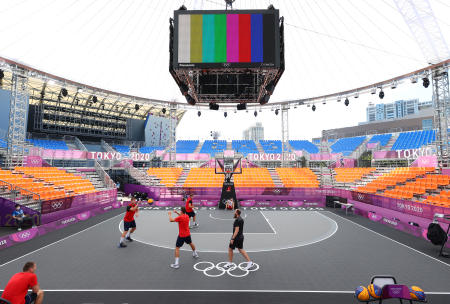
- ARAB NEWS
- 11 Jul 2025

TOKYO: Nuno Duarte claps in Tokyo’s Aomi Urban Sports Park and the sound echoes around the empty stadium, which will host Olympic sport climbers and 3×3 basketball players — but no spectators.
“It’s very strange for the athletes. They are not used to this,” said Duarte, senior audio manager at Olympic Broadcast Services which has created an immersive soundscape for the virus-postponed Games.
While the stands will be empty at Olympic venues in Tokyo, ambient crowd sounds — customised for each sport — are meant to stop arenas feeling like atmosphere-free shells.
To make the soundtracks, Duarte and his team combed audio from Rio 2016 and London 2012 to extract rare unsullied moments of spectator noise and applause.
They painstakingly pieced these clips together over three months, fine-tuning what they hope will immerse TV viewers in the action and encourage athletes without distracting them.
“Sports have their own dynamics. Some of them are very strong, very animated… others require silence because the athletes need concentration,” Duarte said.
For sports not seen in Rio or London like baseball, sport climbing and karate, the team selected similar atmospheres from the archives.
“Karate is very similar to judo for crowd reactions,” explained Duarte, audio manager for OBS, which films and distributes thousands of hours of Games action to television clients worldwide.
Crowd sounds will be played “very low, like a murmur” to avoid stealing the show from the world’s top competitors.
“The sport itself is the most important” element for viewers, Duarte said.
And the quiet venues will offer a unique experience for those watching at home.
“You’re going to listen to details of the sports you never listened to before,” he added.
For the first time, Games footage will be distributed to international networks in 4K, an ultra-high-definition format accompanied by so-called “immersive” sound.
It is the “third dimension of audio”, Duarte said — showing off a microphone resembling a submarine mine, or perhaps a coronavirus particle.
“At the moment, we only have two dimensions, left-right and front-rear. Now we go for up high.”
The operation requires military organisation and is coordinated from a control room at the Olympic media centre.
Three audio supervisors will be there throughout the Games, asking venues to adjust the audio mix when needed.
On TV, it’s important to get a smooth and consistent balance between the sound of the athletes and the canned crowd, said audio supervisor Daniel Bekerman.
“This year the Olympics are completely different,” he said.
Viewers at home will have a level of intimacy with the athletes thanks to the silent stadiums, hearing even the sound of them breathing.
“A lot of emotions are going to be different,” Bekerman said.
AFP